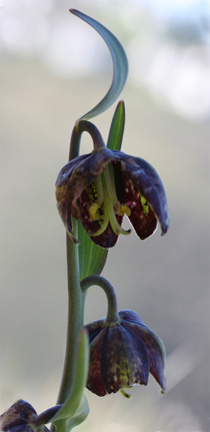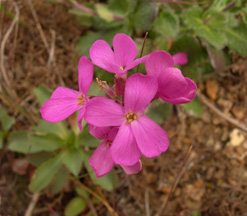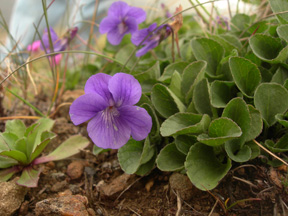
Mission Bells

Rock Cress

Western Dog Violet
Welcome Botanical Illustrators! (first posted February 29, 2013; last updated August 8, 2013)
The purpose of this page is to explain what the Project is all about
and what we need from you as a potential contributor.
The San Bruno Mountains lie just south of San Francisco, just north of the SF airport, and between highways 101 and 280. Most people drive by them each day and think that they are just a bunch of barren hills with radio towers on top. Far from the truth! These flowers were recently photographed there, blooming in January and February, 2013:
Mission Bells |
||
Rock Cress |
Western Dog Violet |
|
In fact, the San Bruno Mountains are a 4 square mile natural area, with 11 species of rare or endangered plants and butterflies. We are trying to help preserve this area by writing a book, The Natural History of the San Bruno Mountains. We hope that this book will help to show people the beauty of the Mountains and to learn why we need to work to preserve it.
Several members of the Yerba Buena chapter (the name of the San Francisco chapter) of the California Native Plant Society are writing a nature guide which should be published by the California Native Plant Society Press. We are going to use line illustrations of the leaves and a few flowers, and that is where you come in. The original guidebook to San Bruno Mountain, A Flora of the San Bruno Mountains, was originally printed in 1968 by the California Academy of Sciences. It was reprinted in 1990 by the California Native Plants Society Press, but is now out of print. These books were written prior to the advent of digital photography, Photoshop, or desktop publishing. There were no color photographs or even line drawings of the plants. We would like to revise and expand this book using the digital tools that are now available.
We are still stuck with the fact that color pictures require expensive paper, but line drawings do not. We expect that we will be limited by the publisher in the number of color photographs we can include, as this is standard in any book contract. I am hoping that with modern, all-digital originals that we will not be limited in black and white illustrations. We want to have something on the same page as the text to help identify the plant, and avoid the indecipherable leaf descriptions that have been used in most books to date. The leaf illustration has to be a black and white illustration simple enough that will print well on the lower-quality paper used for text pages. The illustration, at this point, will be just to identify the leaf, with a bit of venation detail, so that the reader does not have to try to decipher this: “basal and/or cauline, alternate, opposite, rarely whorled, simple to 2+ × compound” (this is the description in Jepson for coyote brush) or “basal, cauline, or both, alternate, [ opposite], simple to compound, petioled; stipules generally small; blade linear to round, entire to toothed or lobed” (dog violet). And that is where botanical illustrations come in. We would like to include botanical illustrations of each leaf on the page where the plant text is. The illustrations can be rather simple (see the Gallery for examples), since their purpose is to replace inscrutable text. We will have color photographs of the plants, but they will most likely be in a separate part of the book, because of the kind of paper required.
It is our intention to donate the copyright and any profits from the book to the California Native Plant Society. We are all donating our time for the research, writing, and photography portions of this Project. We are looking for botanical artists or botanical art students who are also willing to donate their services. What we can offer you is the chance to be published in a nature guidebook. It is our intention that the artists be able to retain all the rights to their works, and only grant a license to allow their works to be used for the book, and possibly a website and educational materials for schools.
We have submitted a proposal for the book to the Executive Director of the California Native Plants Society, and he is enthusiastically supporting our proposal. The Board of the CNPS Press has yet to meet to consider our proposal, but we are highly optimistic, given the fact that the Board reports to the ED, who is supporting us.
At this time, we are only needing line drawings of leaves and a few composite illustrations. I am posting the leaves that I need illustrated on our Gallery. We may also be able to include line drawings of parts of plants and some of these are posted as well. If you find there is a leaf you want to do, please email me and I will post that that leaf is checked out to you. I would suggest an original image size of about 6 inches in height, scanned at 600 dpi in greyscale, not color, and saved as a jpg at compression level 12. You can define the image as greyscale in your scanner software, or after scanning in Photoshop. Line width of 15 for outlines and 8 for details seems to be working, with finer detail in fewer pixels. My experience with scanning illustrations is that the final image looks best if you set your scanner to slightly increase the contrast. This will make the blacks blacker and keep the whites white. This setting is usually chosen in a dialog box that pops up when you define the scanner output format and location. If you do try to do this but can't figure it out, just scan it normally and send it to me; I can fix it if it needs it. Label the image this way: genus_species_common_name_yourlastnamethenfirstinitial_date.jpg. (When I post them on the webpage, I will make a smaller version and add "thumbnail" to the filename. Otherwise, if you right click any image and choose "save file as", you can see how to label your images. If this is confusing, ignore it.)
David Nelson
Yerba Buena chapter, CNPS
(nelsondl followed by the "at" sign, followed by pacbell dot net)